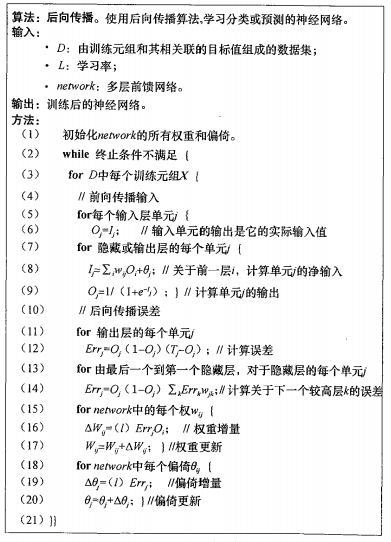神经网络是深度学习的基础。个人理解神经网络就是可以拟合任何一种广义线性模型的结构,本文主要记录python代码的学习笔记。
BP神经网络原理(待补充,可以详见《数据挖掘概念与技术》P258页)
伪代码:
代码中使用的随机梯度下降,伪代码是使用整体数据做梯度下降。
# coding=utf-8
import numpy as np
def tanh(x):
return np.tanh(x)
def tanh_deriv(x):
return 1.0- np.tanh(x)*np.tanh(x)
def logistic(x):
return 1/(1+np.exp(-x))
def logistic_derivative(x):
return logistic(x)*(1-logistic(x))
class NeuralNetwork:
def __init__(self,layers,activation='tanh'):
"""
"""
if activation == 'logistic':
self.activation = logistic
self.activation_deriv = logistic_derivative
elif activation=='tanh':
self.activation = tanh
self.activation_deriv=tanh_deriv
self.weights=[]
self.weights.append((2*np.random.random((layers[0]+1,layers[1]))-1)*0.25)
for i in range(2,len(layers)):
self.weights.append((2*np.random.random((layers[i-1],layers[i]))-1)*0.25)
#self.weights.append((2*np.random.random((layers[i]+1,layers[i+1]))-1)*0.25)
def fit(self,X,y,learning_rate=0.2,epochs=10000):
X = np.atleast_2d(X)
# atlest_2d函数:确认X至少二位的矩阵
temp = np.ones([X.shape[0],X.shape[1]+1])
#初始化矩阵全是1(行数,列数+1是为了有B这个偏向)
temp[:,0:-1]=X
#行全选,第一列到倒数第二列
X=temp
y=np.array(y)
#数据结构转换
for k in range(epochs):
# 抽样梯度下降epochs抽样
i = np.random.randint(X.shape[0])
a = [X[i]]
for l in range(len(self.weights)):
a.append(self.activation(np.dot(a[l],self.weights[l])))
# 向前传播,得到每个节点的输出结果
error = y[i]-a[-1]
# 最后一层错误率
deltas=[error*self.activation_deriv(a[-1])]
for l in range(len(a)-2,0,-1):
deltas.append(deltas[-1].dot(self.weights[l].T)*self.activation_deriv(a[l]))
deltas.reverse()
for i in range(len(self.weights)):
layer = np.atleast_2d(a[i])
delta = np.atleast_2d(deltas[i])
self.weights[i] +=learning_rate*layer.T.dot(delta)
def predict(self,x):
x=np.array(x)
temp= np.ones(x.shape[0]+1)
temp[0:-1]=x
a = temp
for l in range(0,len(self.weights)):
a=self.activation(np.dot(a,self.weights[l]))
return(a)
下面为测试“异或”数据的代码:
因为输入是2个特征的所以输入层为2,隐藏层我随意定义了12,输出层为1(因为结果为0或1所以1位就够定义了。)
from BPNN import NeuralNetwork import numpy as np nn = NeuralNetwork([2,12,1],'tanh') x = np.array([[0,0],[0,1],[1,0],[1,1]]) y = np.array([0,1,1,0]) nn.fit(x,y) for i in [[0,0],[0,1],[1,0],[1,1]]: print(i,nn.predict(i))
代码结果:([0, 0], array([-0.00917032])) ([0, 1], array([ 0.99785397])) ([1, 0], array([ 0.9979288])) ([1, 1], array([ 0.01522156]))
特别感谢:彭亮的指点,给了我很大的帮助。

























 957
957

 被折叠的 条评论
为什么被折叠?
被折叠的 条评论
为什么被折叠?








